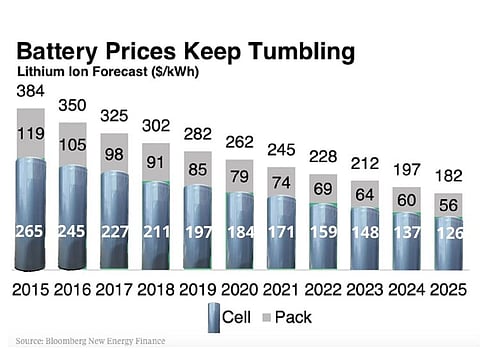Look: Downward slide for electric car battery prices
EV battery packs seen falling below $100 per kWh in the next 3 years

Highlights
- Average cost of lithium-ion battery cell to fall below $100/kwH in 2023, according to IHS Markit projection
- Bloomberg research shows battery packs would even cost lower per kwh
The average cost of a lithium-ion (Li-ion) battery cell will fall below $100 per kilowatt hour (kWh) in the next three years, new research shows. The London-based research firm IHS Markit stated that batteries cells and pack will continue their downward slide in price as they are increasingly used to power electric vehicles and power grids as renewables, such as solar and wind, are added.
It pointed out that the average cost of a li-ion cell is expected to decline further through the end of the decade, to as low as $73/kWh in 2030. The average cost of a lithium-ion (Li-ion) battery has already fallen 82% from 2012-2020.
Further reductions are a key factor to increasing the competitiveness and wider adoption of the batteries for electric transportation, self driving technology, robotaxis and and in grid storage. By 2023, the cost of a battery will have declined 86% (by $580/kWh) in a decade, according to the IHS Markit analysis.
Progress in growing the share of low-carbon generation, such as solar and wind, in the global power mix also brings a particular set of challenges—namely intermittency.Sam Wilkinson, associate director, clean technology and renewables, IHS Markit
“Progress in growing the share of low-carbon generation, such as solar and wind, in the global power mix also brings a particular set of challenges — namely intermittency. Improving cost-effectiveness of energy storage, particularly batteries, will be key to providing needed flexibility to balance this supply of electricity with demand,” said Sam Wilkinson, associate director, clean energy technology, IHS Markit. “Improving cost-effectiveness of energy storage, particularly batteries, will be key to providing needed flexibility to balance this supply of electricity with demand.”
IHS Markit expects that the biggest contributor to falling battery cell costs throughout the coming decade will be reductions in manufacturing costs through larger factory sizes — the "gigafactories" and "terrafactories" of the world — and improving economies of scale. Reductions in material costs by improving efficiencies and adopting lower-cost cathode compositions, and improvements in battery energy density are also expected to play a role.
Among the three major Li-ion battery cells — Nickel Manganese Cobalt (NMC), Nickel Cobalt Aluminum (NCA) and Iron Phosphate (LFP) — LFP has already fallen below the $100/kWh threshold in 2020. All three types are expected to be below the $100 mark by 2024. IHS Markit said LFP will remain the lowest-cost option throughout the next 10 years. However, NMC and NCA will continue to command a majority share of the automotive and transport sector on account of their higher energy density. The research firm IHS Markit was formed in 2016 with the merger of IHS Inc. and Markit Ltd.
Sign up for the Daily Briefing
Get the latest news and updates straight to your inbox









